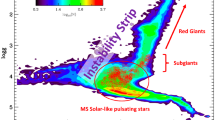“Probable impossibilities are to be preferred to improbable possibilities…”
Aristotle
Abstract
The scientific community has been trying to explain the phenomenon of the origin of life on our planet for many years. Contemporary knowledge makes it possible to establish the logically reliable fact of the formation of the hydrothermal conditions under which this phenomenon emerged naturally following the accretion of protoplanetary matter within the single process of the development of the geographical envelope of primordial planets of novas. Similar processes preceded the appearance of biomorphic remnants in meteorites (chondrites), a parent planet’s debris that fell to the Earth. Hence, the occasional attempts to revive panspermia (the hypothesis that life on the Earth appeared because so-called living embryos had been brought to it from outer space) of the Swedish physical chemist S. Arrhenius (1859–1927) appear irrelevant.
Similar content being viewed by others
References
V. I. Vernadsky, Living Matter (Nauka, Moscow, 1978) [in Russian].
E. M. Galimov, “What is life? Instead of introduction,” in Problems of the Origin and Evolution of the Biosphere (Knizhnyi Dom Librokom, Moscow, 2008) [in Russian].
E. M. Galimov, “The problem of sustainable ordering and the ATP-dependent mechanism of life origin,” in Problems of the Origin and Evolution of the Biosphere (Knizhnyi Dom Librokom, Moscow, 2008) [in Russian].
G. A. Zavarzin, “The evolvement of the biosphere,” Herald Russ. Acad. Sci. 71 (6), 611 (2001).
G. A. Zavarzin, “The first ecosystems on the earth,” in Problems of Life Origin (PIN RAN, Moscow, 2009) [in Russian].
G. A. Zavarzin, “Does evolution make the essence of biology?,” Herald Russ. Acad. Sci. 76 (3), 292 (2006).
A. S. Lopukhin and V. N. Eremeev, “The Ice Age of primordial planets: The origins of the ocean and the rise of the biosphere,” Vestn. Ross. Akad. Nauk, No. 10 (2013).
M. G. Shidlovskii and A. S. Lopukhin, “Microbial expansion in the Archeozoic as the basis for searching and interpreting extraterrestrial analogues,” Herald Russ. Acad. Sci. 84 (4), 310 (2014).
M.-M. Roblot, “Nouveaux Acritarches du Précambrian Normand: Leurs etude à la microsonde électronique,” Compt. Rend. Acad. Sci. 264, 1263 (1967).
A. S. Lopukhin, “New finds of plant microfossils in chalcedonies of vanadium-bearing coal–silicon–shale formations of Tian Shan,” Dokl. Akad. Nauk SSSR 189 (6), 1321 (1969).
H. J. Hofmann, J. Hill, and A. F. King, “Late Precambrian microfossils, Southeastern Newfoundland,” Geological Survey of Canada, Current Research, Part B (1979), pp. 83–98.
A. S. Lopukhin, “Precambrian biofossils and some problems of their study,” in Problems of Precambrian Sedimentary Geology, Ed. by A. V. Sidorenko (Nedra, Moscow, 1975) [in Russian].
A. S. Lopukhin, “Probable ancestors of Cyanophyta in sedimentary rocks of the Precambrian and Palaeozoic,” Geologiska Föreningens i Stockholm Förhandlingar 98, 297 (1976).
H. D. Pflug, “Organic evolution: Essay to the memory of Bartholomew Nagy,” Precambrian Res. 106, 79 (2001).
G. A. Zavarzin, “Initial stages of biosphere evolution,” Herald Russ. Acad. Sci. 80 (6), 522 (2010).
E. M. Galimov, The Phenomenon of Life (Editorial URSS, Moscow, 2001) [in Russian].
M. G. Rutten, The Origin of Life (Elsevier, Amsterdam, 1971; Mir, Moscow, 1978).
The Early History of the Earth, Ed. by B. F. Windley (John Wiley and Sons, London, 1976; Mir, Moscow, 1980).
J. W. Schopf and B. M. Packer, “Early Archaean (3.3billion to 3.5-billion-year-old) microfossils from Warrawoona Group. Australia,” Science 237, 70 (1987).
Author information
Authors and Affiliations
Corresponding author
Additional information
Original Russian Text © A.S. Lopukhin, 2015, published in Vestnik Rossiiskoi Akademii Nauk, 2015, Vol. 85, No. 10, pp. 916–921.
In Memory of Vladimir Vasil’evich Menner
Rights and permissions
About this article
Cite this article
Lopukhin, A.S. The origin of life is the prerogative of primordial planets of novas. Her. Russ. Acad. Sci. 85, 453–458 (2015). https://doi.org/10.1134/S1019331615030028
Published:
Issue Date:
DOI: https://doi.org/10.1134/S1019331615030028




